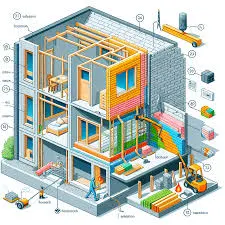Definition: Electric heater or cooler sizing refers to determining the appropriate power output (heaters) or cooling capacity (coolers) needed to effectively maintain a desired temperature in a specific space.
Click the Translate button(see right) on this post to set your Own Language to understand more perfectly!!
Electric Heater Sizing Calculator
°C
°C
m³/s
J/kg°C
kg/m³
Definition Continue:
Electric Heater and Cooler Sizing
Electric heater or cooler sizing refers to determining the appropriate power output (heaters) or cooling capacity (coolers) needed to effectively maintain a desired temperature in a specific space. This is crucial for achieving comfort and energy efficiency.
Factors affecting sizing:
Room size (square footage): Larger spaces require more powerful heaters/coolers.
Insulation level: Well-insulated spaces lose heat/gain heat slower, needing less power.
Climate: Colder climates require stronger heaters, while hotter climates need more powerful coolers.
Ceiling height: Higher ceilings require more powerful units.
Number of occupants: More people generate heat, affecting cooling needs.
Heater Materials (with Example):
Ceramic: Emits radiant heat (heat lamps) - High density (around 2700 kg/m³)
Metal: Conducts heat efficiently (fan heaters) - Varies depending on metal (e.g., Aluminum - 2700 kg/m³, Steel - 7800 kg/m³)
Nichrome: Resistive heating element (convection heaters) - High density (around 8900 kg/m³)
Quartz: Infrared radiant heat (infrared heaters) - High density (around 2650 kg/m³)
Silicone: Heating element insulator (various heaters) - Low density (around 1100 kg/m³)
Cooler Materials (with Example):
Copper: Excellent heat conductor (air conditioners) - High density (around 8960 kg/m³)
Aluminum: Lightweight and good conductor (evaporative coolers) - Low density (around 2700 kg/m³)
Plastic: Durable and lightweight (cooler bodies) - Varies depending on plastic type (e.g., ABS - 1900 kg/m³, PET - 1350 kg/m³)
Hydrofluorocarbons (HFCs): Refrigerant in air conditioners (not a solid material)
Cellulose: Absorbent material in evaporative coolers (not a solid material)
Example - Heater: A ceramic space heater uses radiant heat to warm a small bathroom (ceramic - high density for heat retention).
Example - Cooler: A window-mounted air conditioner with copper coils and an aluminum evaporator cools a bedroom (copper - good heat conductor, aluminum - lightweight for efficient cooling).
Sizing Resources:While material properties are important, heater/cooler sizing primarily relies on factors mentioned earlier
How it is possible to earn money using the knowledge of Heater & Cooling Design Calculation?????
Here are 10 ways to earn money using your knowledge of Heater & Cooling Design Calculation:
Direct application of your knowledge:
HVAC Consultant: Offer design and calculation services for residential and commercial HVAC systems. This could involve designing new systems, analyzing existing systems for efficiency improvements, and troubleshooting problems.
Freelance Design Work: Partner with architects, engineers, or contractors on specific projects, providing calculations and design expertise for heating and cooling systems.
Energy Efficiency Auditor: Conduct audits for homes and businesses to identify areas for improving heating and cooling efficiency.
Solar Thermal System Design: Design and optimize solar thermal systems that use solar energy for heating needs, a growing field.
Sharing your knowledge:
Online Course Creation: Develop and sell online courses teaching heater & cooling design calculations. Platforms like Udemy, Skillshare, or even your own website can host your course.
Technical Writing: Write manuals, guides, or blog posts explaining heater & cooler design calculations for different audiences (e.g., contractors, DIY enthusiasts).
YouTube Channel: Create educational videos on your channel, explaining concepts and showcasing calculations for different scenarios.
Using your knowledge in adjacent fields:
Home Improvement Consultant: Offer consultations to homeowners, advising them on the best heating and cooling solutions for their needs.
Product Development: Work with manufacturers to develop new and innovative heating and cooling systems, applying your design knowledge.
Energy Efficiency Advocate: Use your expertise to educate the public about energy-efficient heating and cooling practices, potentially working with NGOs or government agencies.
These are just a few ideas, and the best path for you depends on your specific interests and skills. You can combine these approaches to create a unique income stream.
Do YOU Want To Earn Money In Various Ways, Click The Link & Explore Your Field of Interest!!!









